Modified on: 28/09/2024
What are the effects of cannabidiol depending on how it is taken? What is meant by bioavailability? How ‘efficient’ is CBD?
Today we would like to take a closer look at one of the most popular but least analysed topics in the CBD universe: bioavailability.
Many people talk about it, but are we sure it is always discussed correctly?
In this article, we will see what is meant by the bioavailability of cannabidiol, what factors and variables it depends on and why it is an essential concept that should always be taken into account.
We will see how it is not such a complex concept and difficult to measure, but rather how it is, with the right precautions and advice, a factor within the reach of everyone, even those who do not have a laboratory with expensive chemical equipment in their home!
That said, we would like to remind you that our articles are only intended to inform you and provide you with a summary of the trends in vogue in the cannabis world and are in no way intended to encourage any illicit practice.
Before we leave you to the article, we invite you to visit the Justbob shop where you can find numerous products, suitable for the most varied tastes, based on CBD and legal hash.
Well, having concluded the necessary premise, all that remains is to wish you good reading!
What is CBD and how does it affect our organism?
We think it is useful, before going into detail in our in-depth study on bioavailability, to do a little review and briefly remind ourselves what CBD is and what its properties are.
CBD, also known as cannabidiol in full, is a cannabinoid with no psychoactive effects and is not harmful to the body. Its beneficial properties are now recognised and proven by researchers, among which are those that are:
- anti-inflammatory;
- pain-relieving;
- relaxing;
- sedative;
- antioxidant;
- antibacterial.
For this reason, CBD is now increasingly used therapeutically in the treatment of various diseases and disorders. Cannabidiol is enjoying great success in the medical field because it is completely natural, because it is non-addictive and above all because it has no major side effects.
To be fair, some negative and undesirable side effects may occur, but they are very rare and often completely negligible, but it is always better to be cautious, so let us mention a few side effects such as:
- mood alteration;
- increased or decreased appetite;
- drowsiness;
- reduced reflexes and coordination problems.
Remember that CBD can cause problems if taken in conjunction with other drugs, so as usual, we urge caution as cannabidiol may interfere with other medicines.


What is CBD bioavailability and what does it depend on
Here we come to the focal point of our article, namely what does bioavailability mean?
It is an expression used to define the efficiency of any drug, but now we will see what it means in the specific case of CBD.
It is a concept that refers to the percentage of cannabidiol that actually reaches the bloodstream and therefore causes effects.
In other words, if the CBD in question has a high bioavailability, a minimal dose will suffice to enjoy its effects. In a nutshell: the greater its bioavailability, the lower the active ingredient to be taken.
Yes, because we well understand how those who want to benefit from cannabidiol are concerned that the product is efficient and therefore want to avoid part of the product being wasted or not fully utilised.
But we have to deliver some bad news straight away: it is impossible for CBD, like no other supplement on the other hand, to achieve a 100% bioavailability.
But what does bioavailability depend on?
On several factors, but the main one is its mode of intake.
In fact, its effectiveness and efficiency depend on the forms in which it is administered; there will be some that are cheaper and more optimal and others that are less convenient. In these cases, it is important to keep in mind the phrase: achieve maximum results with minimum effort!
The different forms of cannabidiol intake
But what are the various forms in which CBD can be found? Various CBD products can be found on the market, for a variety of tastes and needs, including:
- CBD oil;
- creams, lotions and gels;
- crystals;
- flowers, buds, pollens and resins;
- capsules;
- candies and other edible substances;
- cosmetics.
But what are the ways of taking CBD that guarantee the best bioavailability?
The most efficient and effective ways of administration are:
- oral intake: this method refers to capsules, crystals, candies and other edibles. In this way, cannabidiol is guaranteed to be absorbed and pass into the gastrointestinal tract, reaching a bioavailability of between 4% and 20%;
- by the sublingual route: by this we especially mean CBD oil, the drops of which are applied under the tongue. In this case, the substance enters the bloodstream directly without losing precious time in the digestive tract, and therefore the bioavailability is between 12 and 35 %. It is estimated that the first effects occur already after 15 minutes;
- by inhalation: this is the most efficient and rapid of the methods considered, as absorption in the lungs is immediate and passes immediately into the bloodstream. Bioavailability here is between 34% and 56%! We would like to point out that this practice is not legal in many countries, in the UK for example THC must not exceed 0.2% at all;
- topical use, via creams or gels: this particular aspect is still being studied, although some research claims that this way can have a bioavailability of 34%, 46%, but we await the development of further tests before we finally expose ourselves in such triumphalist terms.
Are there any tricks to increase the bioavailability of CBD?
We don’t want to disappoint you, there are no real tricks, no magic shortcuts!
No tricks, rather there are ways to increase the effectiveness of cannabidiol, let’s look at them together:
- take CBD with fat-rich foods: cannabidiol, being a fat-soluble molecule, binds to fat, so it has been shown to enter the bloodstream immediately, increasing and speeding up its effects on the body. The healthiest fatty foods used for this purpose are fish, avocados, nuts and peanuts, coconut, sesame and olive oil. But it’s not just fatty foods, some researchers have noted that certain spices, being rich in terpenes, can also help increase the bioavailability of CBD, spices include turmeric, rosemary and pepper;
- combining CBD with melatonin: for those who want to achieve relaxing and sedative effects, perhaps because they have difficulty sleeping or would like to regulate the sleep/wake cycle during jet lag, it has been found that cannabidiol taken in synergy with melatonin can be very effective;
- CBD nanoemulsions: state-of-the-art nanotechnology enables the creation of small lipid spheres that allow CBD to be absorbed quickly and immediately, greatly increasing the bioavailability of cannabidiol in the body.
According to experts, another tip would be to hold for at least 30 seconds the CBD oil under the tongue before swallowing it.


What is the optimal dosage and how to find out
Bioavailability, i.e. the times and ways in which the substance enters the bloodstream, ensuring the effects of CBD, varies from person to person depending on many individual aspects including:
- metabolism;
- age;
- weight;
- genetic phenotype;
- the individual’s particular psycho-physical health status;
- tolerance threshold and consumption habit.
But what is the ideal dosage recommended by experts?
Taking into account subjective aspects, which are by no means negligible, experts generally recommend proceeding step by step, i.e. starting with a minimum dosage and then gradually increasing the amount to be administered.
To be specific, it is usually recommended to start cautiously, with 10-20 drops per day of 24% CBD oil which would correspond to 70-140 mg CBD.
Therefore, one starts with a microdose and then switches to a medium dose depending on the effects and needs.
Although no cases of overdose have been demonstrated, we always urge caution and avoid taking CBD with other, even mild, medications.
Read also: No, CBD oil (and other cannabidiol products) is not addictive. This is why
Conclusion
Here we come to the end of our in-depth study on bioavailability.
The subject was not an easy one, but we wanted to show you, and we hope we have succeeded, that the various aspects involved may be less complex than you think.
You don’t have to be a biochemist or have shelves full of Nobel prizes to understand how effective cannabidiol is and what the ideal way of taking it might be to fully benefit from its active ingredient.
But bioavailability refers not only to the time in which CBD takes effect, but also to the intensity of the effects and their perceived duration.
It seems understandable to us that the reader is interested in not losing valuable cannabidiol and in enjoying its effects in a complete and efficient manner.
As usual, however, we would like to reiterate that it is important for us to respect the law and current regulations governing the use of cannabis, which is why we invite you to explore our shop where you will find strictly legal articles!
Thank you very much for your attention and patience, we hope to see you soon on our pages!
Takeaways
- Bioavailability refers to the efficiency of a pharmaceutical substance in reaching the bloodstream and producing effects in the body. In the case of CBD, it indicates the percentage of cannabidiol that effectively enters the bloodstream and induces desired effects.
- The efficiency of CBD depends on the method of administration. Oral, sublingual, and inhalation methods are among the most efficient, with oral and sublingual administration typically exhibiting bioavailability ranging from 12% to 35%, while inhalation can reach up to 56%.
- While there are no magical tricks to increase CBD bioavailability, certain practices can enhance its effectiveness. These include consuming CBD with fat-rich foods, combining it with melatonin for relaxing and sedative effects, and using nanoemulsions for rapid absorption.
- The optimal dosage of CBD varies from person to person and depends on individual factors such as metabolism, age, weight, and health status. Starting with a microdose and gradually increasing based on effects and needs is generally recommended.
- Understanding CBD bioavailability is crucial for maximizing the desired effects of cannabidiol. While there’s no one-size-fits-all approach to optimizing bioavailability, knowing about different administration methods and practices to enhance it can help fully leverage the benefits of CBD.
FAQ
What are the effects of cannabidiol depending on how it is taken?
The effects of cannabidiol (CBD) can vary depending on the method of intake. For example, oral intake, sublingual administration, inhalation, and topical use can all influence how quickly CBD is absorbed into the bloodstream and how long its effects last.
What is meant by bioavailability?
Bioavailability refers to the percentage of a substance that enters the bloodstream and produces its effects. In the case of CBD, bioavailability is influenced by factors such as the method of administration and the individual’s metabolism.
How ‘efficient’ is CBD?
CBD’s efficiency can vary depending on its bioavailability, which is affected by factors like the method of intake. For example, oral intake, sublingual administration, inhalation, and topical use all have different bioavailability rates.









